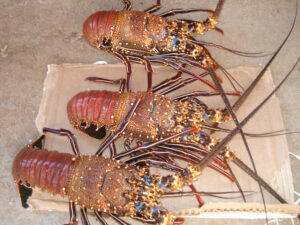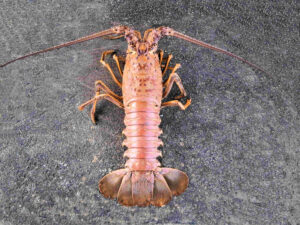California Spiny Lobster, Panulirus interruptus


 California Spiny Lobster, Panulirus interruptus. Lobster courtesy of the commercial fishermen of the greater Los Cabos area, Baja California Sur, December 2012. Size: 30 cm (11.8 inches).
California Spiny Lobster, Panulirus interruptus. Lobster courtesy of the commercial fishermen of the greater Los Cabos area, Baja California Sur, December 2012. Size: 30 cm (11.8 inches).
Phylogeny: The California Spiny Lobster, Panulirus interruptus (Randall, 1840), is a member of the Palinuridae Family of Spiny Lobsters, and are known in Mexico as langosta Californiana and langosta colorada.
Morphology: The California Spiny Lobster are reddish-brown in color with a lighter stripe running the length of each leg and a carapace with two dark eyespots at the front. They have a pair of enlarged spiny antennae and interrupted grooves across the tail which are unique to this species. They lack claws but have very strong mandibles that are used for crushing shells. The spines of the California Spiny Lobster are not as sharp as those of more tropical species, but their spines and horns over the eyes are easily capable of puncturing human skin. California Spiny Lobsters can reach 70 cm (2 feet 4 inches) in length and 12 kg (26 lbs) in weight, but are normally half that size. They are sexually dimorphic with males being larger than females. Males can be distinguished from females by the position of two round genital openings (gonopores); in females the gonopores are at the base of the third pair of pereiopods and in males they are at the base of the fifth pair.
Habitat and Distribution: California Spiny Lobsters shelter in large groups in rocky reefs during daylight hours and are found from the lower intertidal zone to depths up to 76 m (250 feet). They undergo an annual migration to shallow water in the spring and return to deeper waters in the winter. In Mexican waters the California Spiny Lobsters is found in the Pacific Ocean from Central California to Magdalena Bay, Baja California Sur and in small pockets of the extreme southern Sea of Cortez, including Las Frailes and Cabo San Lucas.
Diet: The California Spiny Lobster is omnivorous and emerges at night to feed on algae, sea clams, mussels, urchins, worms, and detritus.
Reproduction and Development: The California Spiny Lobster has a two-year reproductive cycle. Males attach a spermatophore onto the sternum of the female. Then, females move into shallow water and extrude approximately 50,000 to 80,000 eggs, which are then fertilized by sperm from the spermatophore. Masses of these fertilized eggs attach to the pleopods of the females. They grow by periodically molting their exoskeleton, and lost appendages can be replaced at this time. The lobster reaches maturity at about five years of age and they have life spans of between thirty and fifty years.
Behavior: The California Spiny Lobsters utilizes its ability of make a loud rasping sound and the retreat backwards as defense mechanisms.
Ecosystem Role: The California Spiny Lobster plays an important role in the ecosystem limiting sea urchin populations. In turn they are preyed upon by California Sheepshead, Cabezon, Kelp Bass, Giant Sea Bass, Horn Sharks, Leopard Sharks, Sea Otters and various octopi, moray eels and rockfishes.
Human Impact: The California Spiny Lobster is fished extensively by commercial fishermen as they are considered to be an excellent human food. At present they are the most economically important lobster on the West Coast with about half the catch being made by recreational sportfishernen (250,000 kg or 560,000 lbs per year) with hoop nets and the other half made by commercial fishermen with lobster traps. They are heavily regulated in both California and Mexico with restrictions on gear employed, fishing seasons, and size and bag limits. They represent the fifth most valuable fishery in Mexico with sales at a level of $18,000,000 (800 tons) annually.
Synonym: Palinurus interruptus.